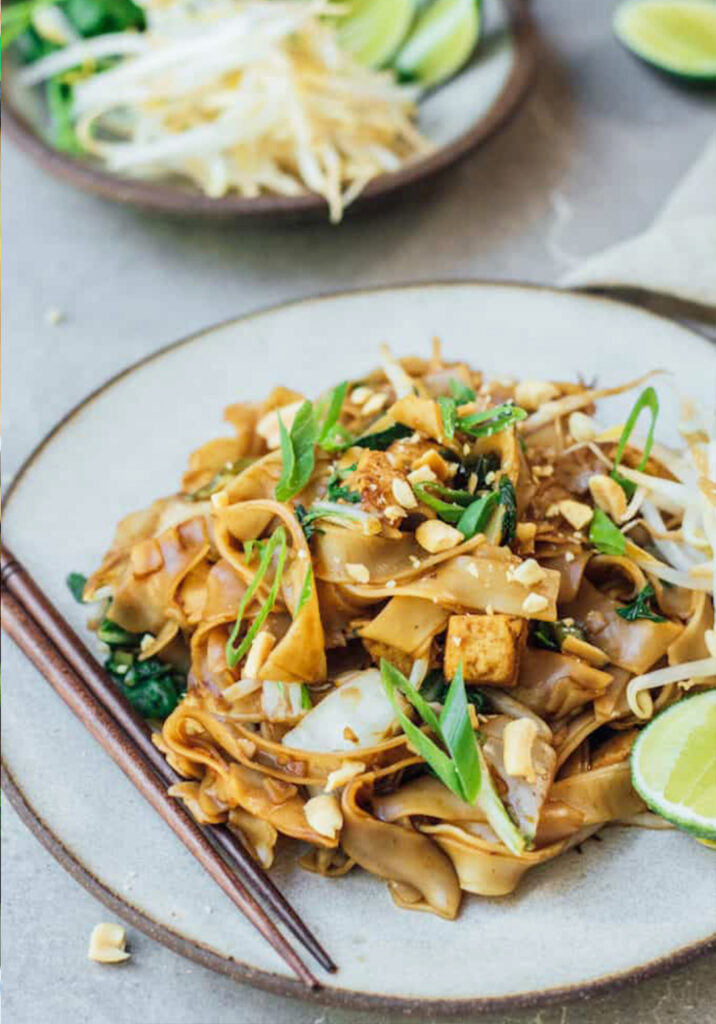
These are one of my favourite noodles and i’m sure it the same for many of you!
The term ‘Pad’ means to stir-fry and the term ‘See Ew’ means soy sauce. So the dish litterly means stir fry soy sauce.
If you never had Pad See Ew but you had Pad Thai before you can say that it’s a cousin of Pad Thai but sweeter and more chewy noodles. The regular Pad See Ew uses the wide rice noodles but you can use smaller noodles if you like that.
This dish is so easy and quick with only a few ingredients that it’s perfect to make at home. Its also very versatile you can make it as vegan or meaty as you like. That’s also why I love making this when friend come over.
What Noodles to use for Pad See Ew.
For Pad See Ew you want to go for the Wide Rice Noodles. My opionion, the thiccer the better!!!
If you get dry noodles, soak them in room temperature water for at least 30min. until they are soft. Don’t cook them in hot boiling water!
If you buy fresh rice noodles from the store and they’re cold, hard and stuck together into a big block, you’ll need to heat them (I do this in the microwave) until they’re hot and softened, and you will be able to separate them then.
What is Chinese broccoli a.k.a. Gai Lan?
Most of you are familiar with a Chinese restaurant dish with long stems of steamed green leaves on a plate with oyster sauce drizzled on top. These greens are called Gai Lan (Chinese Broccoli) and you can get them at any Asian Supermarket. If you don’t have an asian supermarket near you, you can use regular broccoli. You see in a lot of asian restaurants here in Amsterdam that they use regular broccoli because its less expensive. But if you make it at home, its worth getting the Chinese broccoli.
Tips for preparing Gai Lan.
Chinese broccoli, especially older ones, can be chewy, but this isn’t a problem if you know how to deal with them. You want to make sure you slice any thick stems thinly (on a bias so you still get nice large pieces) and then you won’t need to peel the stems as some people might do.For the leaves, make sure you only cook them until they’re wilted and remove them from the heat immediately. Cooking gai lan for a long time tends to make leaves that are super wilty and chewy.
Condiments on the side to give it that bit extra yumyum.
In a lot of restaurants you get some extra sides to add to your Pad See Ew. You don’t need to add it. But it gives it just that extra kick of flavour. A few common sides are, freshly cut limes, beansprouts, coriander and crushed peanuts.
Pad See Ew (Thai Rice Noodles)
Ingredients
For the sauce
- 2 Tbsp sweet dark soy sauce (can use Ketjap if you have that, but that with ½ Tbsp because its more salty and adjust to taste)
- 1 Tbsp Regular soy sauce (I like to use Mushroom soy sauce)
- 1 Tbsp oyster sauce
- 1 tsp sugar or honey
- 1 Tbsp Golden mountain sauce (or use extra regular soy sauce)
For the noodles
- 3-4 Tbsp Vegetable oil
- 4 gloves garlic (minced) (I love using pre cut frozen garlic)
- 4-6 stalks Chinese broccoli (Gai lan) (you can use regular broccoli)
- 2 Eggs
- 170 g Protein of choice (I used Tofu)
- 1 Tbsp Soy sauce for marinating Tofu, meat or shrimp
- 400 g Wide rice noodles
- 1 tbsp white pepper
Instructions
- Mix the tofu and 1 Tbsp of soy sauce together. Let it sit while you prep the other ingredients.
- Combine all sauce ingredients together and stir to mix well.
- Add vegetable oil and garlic to the wok and sauté over medium high heat until the smallest bits of garlic starts to turn colour.
- Add tofu or meat until its 80% cooked.
- Add egg, break the yolk, let it set just about halfway, then scramble briefly.
- Add 200g rice noodles, Chinese broccoli and the sauce mix. Turn the heat up to high and toss to coat the noodles evenly in the sauce. Once coated, spread the noodles out to cover the entire pan and let them sit without stirring for about 15-30 seconds until some of the noodles have “toasted” i.e. have some charred marks on them (how long this takes depends on how hot your stove gets). Flip the noodles and let them sit again to toast the other side. You may flip the noodles again a couple more times to get more toasting if you wish.
- Plate the noodles, then quickly wipe the pan clean with paper towel and cook the next serving. (If you are making this for a big group)
- Enjoy!

Leave a Reply